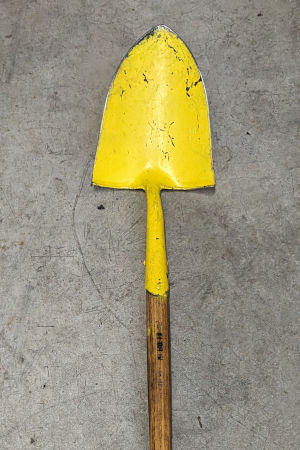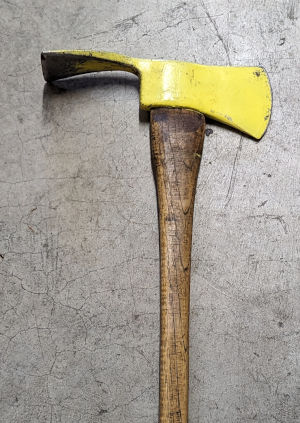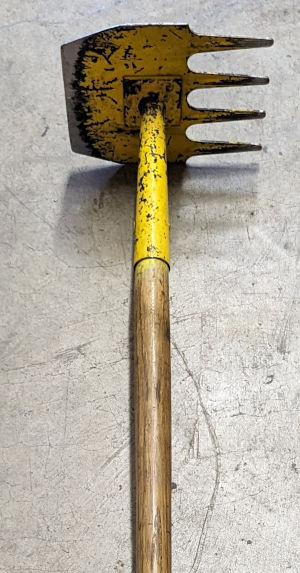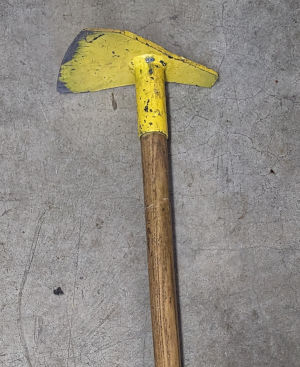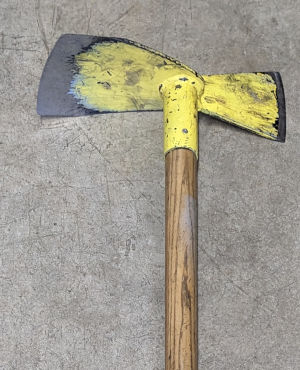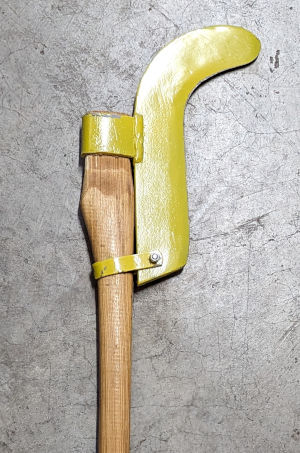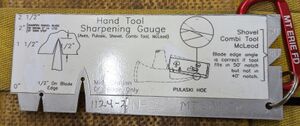Wildland Hand Tools
Tools We Carry
Shovel
Shovels are good for digging, scraping, tamping, and throwing dirt. They can also be used to de-limb lower branches on trees to reduce ladder fuels. They tend to be heavy, but have a long handle.
Sharpening
Sharpen the blade of a shovel starting 1.5 in. (38 mm) from the heel on each side of the blade until a subtle point is formed at the tip of the blade. Do the same number of strokes — and with the same amount of pressure — with a 12-in. flat bastard file on each side so that the shovel point does not drift from the center line.
See this video for a shovel sharpening demonstration: https://youtu.be/3TrehiITIYM?t=209
Pulaski
The Pulaski is a grubbing and cutting tool. It is made with a standard axe handle. The axe side can be used for cutting trees, shrubs, and roots. The adz end can be used for scraping and grubbing in line construction.
Sharpening
- Taper the cutting edge 2 in. (50 mm) wide with an even bevel on each side.
- Bevel the grubbing edge 3/8 in. (10 mm) wide straight across on a 45-degree angle on one side of the head only.
See a video here: https://youtu.be/3TrehiITIYM?t=13
McLeod/Wilson
A long handled tool, the McLeod has tines on one side for pulling brush and a hoe edge on the other. These are sometimes called Wilsons due to their resemblance to Tom Hanks's volleyball in Cast Away. Our McLeods have been cut down so they are narrower, because the wide profile made pulling blackberries and other shrubs very difficult. It is primarily a scraping tool, but can also cut small shrubs and limbs.
Sharpening
The hoe blade portion of the McLeod should be beveled to 45-degree angle with the 12-in. flat bastard file on the outside face of the blade making sure the blade stays straight. The tines are not sharpened.
See this video: https://youtu.be/3TrehiITIYM?t=305
Rogue Hoe
The rogue hoe is a grubbing and scraping tool. It has a medium length handle and is one of the lighter line construction tools. The wide side can be used to cut limbs or small shrubs as well as for scraping. The narrow edge can get between rocks and other narrow areas. Both ends are sharpened.
Sharpening
Sharpen the narrow end one one side at a 45 degree angle. The wide end is sharpened along its long edge and both short edges. Only on one side and at a 45 degree angle.
Super P
The Super P has an axe blade like a Pulaski on one side and a hoe like a rogue hoe on the other. This makes it a versatile cutting as well as grubbing tool. The wider hoe moves more dirt than the adz of a Pulaski. It has a longer handle, but also weighs more than a Pulaski.
Sharpening
Sharpening is done like a Pulaski.
- Taper the cutting edge 2 in. (50 mm) wide with an even bevel on each side.
- Bevel the grubbing edge 3/8 in. (10 mm) wide straight across on a 45-degree angle on one side of the head only.
Combi Tool
The combi tool has a long handle and a locking collar that allows you to open and close the mini shovel on one side and a long pick on the other. It can be setup like a shovel, like a hoe, like a pick, or some combination. It is one of the most versatile tools, but also the most fragile. Proper cleaning and maintenance of the collar are very important. The long pick can be extremely useful on Fidalgo Island because of the cracked rocks in which we often fight fire. Be careful prying with the pick as it isn't as strong as fixed tools.
Sharpening
Sharpen the shovel like a shovel: Sharpen the blade of a shovel starting 1.5 in. (38 mm) from the heel on each side of the blade until a subtle point is formed at the tip of the blade. Do the same number of strokes — and with the same amount of pressure — with a 12-in. flat bastard file on each side so that the shovel point does not drift from the center line.
Sharpen the pick at a 45 degree angle on edge.
Brush Hook
Also called a brush axe, the brush hook can be used for clearing brush and small trees. You swing the brush hook much like you would swing an axe. When not in use the brush hook must be sheathed as the cutting edge is very sharp.
Sharpening
A sharpened cutting edge is on the inside of the head. Sharpen all the cutting edges from 1 in. (25.4 mm) at the base to 3/4 in. (19 mm) at the tip.
Sharpening Tools
Each hand tool must be kept sharpened to make cutting and grubbing more efficient. The sharpened edge and technique is different on each tool.
On short duration fires sharpening may happen only after we have returned to the station in that case consider using the vice on the workbench to hold the tool during sharpening. On longer operations you may need to file your tool in the field to keep it as efficient and useful as possible.
The most important tool you need is a 12 inch mill bastard file . The file must have a handle to prevent puncturing your palm with the 'spike' end of the file.
The department has several aluminum sharpening guides which provide correct edge angles for a number of the tools. Please use these guides, but know they are difficult to come by so don't lose them or loan them out (we'll never see them again).
PPE While Sharpening
The following PPE must be worn while sharpening in the field or at the station:
- Leather wildland gloves
- Safety glasses
- Long sleeve shirt or jacket
Sharpening Technique
When using a mill bastard file for sharpening use long strokes in one direction only. Do not go 'back and forth' with the file. Move the file so your hands are moving away from the cutting edge.
This video covers sharpening of a shovel, Pulaski, and McLeod: https://www.youtube.com/watch?v=3TrehiITIYM
Jump to particular tools:
- Pulaski: https://youtu.be/3TrehiITIYM?t=13
- Shovel: https://youtu.be/3TrehiITIYM?t=209
- McLeod: https://youtu.be/3TrehiITIYM?t=305
Handle Maintenance
Wooden handles need special care. Be sure to clean and dry all handles before returning to the apparatus or storage. All handles should be smooth and free of rough spots and splinters. If the handle is not smooth, use sand paper to smooth out any rough areas. Afterward apply linseed oil with a rag and wipe away excess. Used rags must be placed in flam buckets (as they can autoignite) and linseed oil must be kept in the flam cabinet.
If a handle is cracked or loose in the tool head they must be replaced. Put the tool out of service until it can be repaired or replaced.
